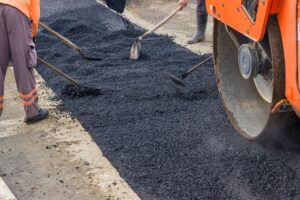 Having a safe, attractive pavement is critical, but so is protecting it from premature deterioration that can result in expensive remediation efforts. A pothole is the bane of motorists, pedestrians, and cyclists everywhere. However, they can also cost you a significant amount of money in additional repairs if you neglect them too long. It is always more cost-effective to prevent pavement damage than to repair it.
Having a safe, attractive pavement is critical, but so is protecting it from premature deterioration that can result in expensive remediation efforts. A pothole is the bane of motorists, pedestrians, and cyclists everywhere. However, they can also cost you a significant amount of money in additional repairs if you neglect them too long. It is always more cost-effective to prevent pavement damage than to repair it.
What Causes Potholes in Asphalt Pavements?
Typically, the need for a pothole repair starts with water that has penetrated beneath the surface of the pavement. The water entered through open cracks or other breaks in the pavement. In the winter, the water freezes and expands in all directions, inflicting damage throughout the pavement’s structure. When warmer weather arrives, the ice thaws, leaving an empty space beneath the pavement. As vehicles pass over the compromised area, the pavement loses its ability to support the weight. The pavement breaks and crumbles, and rain and traffic can dislodge these crumbs, leaving behind an empty hole.
Is It Possible to Prevent Potholes?
Although there is no guarantee that you will never need another pothole repair, an effective asphalt maintenance plan can help. A good paving maintenance plan should include periodic applications of sealcoating. Sealcoating reduces your need for paving repairs by blocking the UV rays and vehicle fluids that can destroy asphalt pavements. Asphalt repairs to seal or fill cracks are also essential. If you are proactive about your paving repairs, you limit how much access water can have to penetrate beneath the pavement.
How Do Contractors Make a Pothole Repair?
The paving repair method of choice is typically asphalt patching. Asphalt pavement patching usually consists of the following steps.
1. The contractor will clean the hole to remove vegetation, broken pavement, dirt, and debris.
2. The contractor marks off a square or rectangle of damaged pavement slightly larger than the hole. For full-depth asphalt patching, the contractor will remove all layers of the pavement to access the base to repair it. If the contractor chooses partial-depth pavement patching, the technique is almost identical. The primary difference is that the contractor will not remove all layers of the pavement. Therefore, this technique does not expose the base, so the contractor cannot repair it.
3. The contractor will then use hot mix asphalt to replace the asphalt courses, compacting each course before installing the next.
4. If the hole is extremely shallow, the contractor might apply a skin patch. This method only requires the contractor to remove any broken bits in or around the hole.
5. There are also products specifically for asphalt paving repairs in cold weather. For example, cold mix asphalt contains additives that keep it workable at lower temperatures than hot mix asphalt.
Whether you need paving maintenance or asphalt repair, you can count on Royal Pavement for work of the highest quality. Our services include asphalt paving and patching, sealcoating, asphalt milling, lot striping, asphalt crack repairs, building maintenance, parking lot sweeping, site work, and concrete installation and repair. We have an exemplary reputation and impeccable references, so contact us today for a free quote. You can call 844-777-7924, fill out the online form, or email [email protected].

